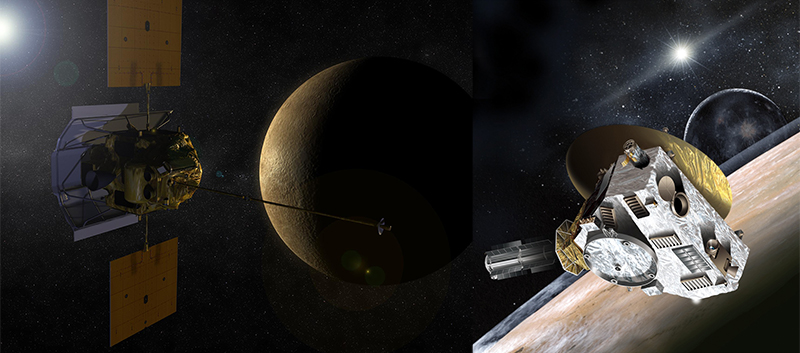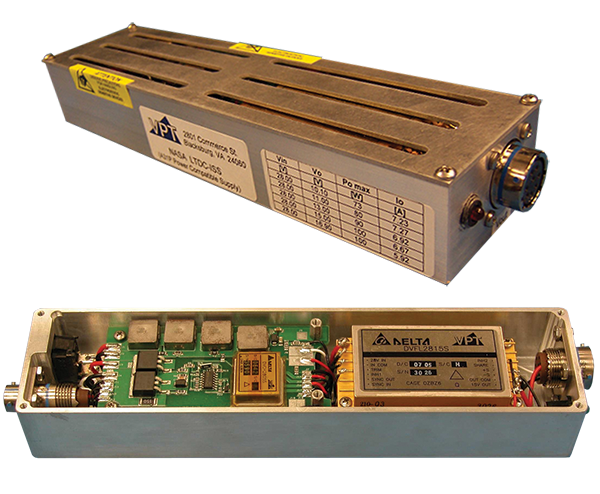
Power Converters Secure Electronics in Harsh Environments
NASA Technology
“Space weather” is a term more frequently used as solar storms and flares are closely monitored and analyzed for the impact they might have on Earth. Blasts of radiation, if strong enough, can make their presence felt by temporarily shutting down power grids or interrupting communication channels. While such events on the Earth’s surface are rare, thanks to the planet’s many layers of protection, the threat posed by radiation to satellites and spacecraft is always on the minds of the engineers who design them.
In fact, many ordinary challenges have to be reexamined when considered in an extreme environment. One prime example is power conversion. A basic problem in electrical engineering is that individual components of a complex device, such as a mobile phone or computer, require different amounts of power to function properly. These issues are solved by using a power converter, which takes voltage from a power source and routes the correct amount of power wherever it is needed.
In space, however, power systems are especially at risk to radiation damage from the Sun and extra-solar-system sources. These high energy particles wreak havoc on electrical components over time, slowly degrading their performance until eventually they fail—and in some cases even a single particle can cause serious damage. This problem has become more acute over time, as spacecraft components and electronics have become smaller and more precise, essentially making them more vulnerable as the radiation particles have become by comparison larger.
According to Sabbir Hossain, an electrical engineer in the Energy Systems Division at Johnson Space Center, power converters “have for many years been inconsistent in quality and performance, and have sometimes failed catastrophically in flight hardware. The complexity and cost of these parts can have a severe impact on a mission’s schedule and budget.” NASA thus decided to form a partnership with industry experts to meet the challenges posed by radiation in space.
Technology Transfer
In 2004, Johnson awarded the first of multiple Small Business Innovation Research (SBIR) contracts to Blacksburg, Virginia-based VPT Inc. to create a line of hybrid DC-DC power converters for aerospace applications. “The idea of the project was to develop standard, off the shelf converters that could be used to put together full power system solutions for NASA programs,” says Leonard Leslie, manager of space programs at VPT.
VPT has long manufactured DC-DC converters, so the primary challenge in this project was to make a line of converters that met the radiation quality requirements of space applications. That meant selecting the right components—picking among materials that are known to be robust—and putting those components through a large amount of testing. Leslie says the company also reengineered circuit design techniques to increase the converters’ resistance to radiation.
“VPT developed an innovative concept whereby complex NASA power systems can be configured using a small number of qualified converters,” says Hossain. “This significantly improved mission scheduling, as the most difficult part of the design—the power stage—became readily available in a standard package.”
The resulting converters, hardened against radiation, have been employed on multiple important NASA missions, including the Mercury MESSENGER probe, the New Horizons mission to Pluto, and the Lunar Reconnaissance Orbiter.
As part of the work carried out under its Phase I and II SBIR contracts, VPT’s converters achieved a major industry certification from the Defense Logistics Agency (DLA), an organization that oversees military specifications. The Radiation Hardness Assurance Requirements certification from DLA, Leslie says, “was a major accomplishment that resulted from our partnership with NASA. The inclusion of testing for enhanced low dose rate component sensitivity (ELDRS) as part of the RHA plan has been adopted as an industry standard.”
Benefits
VPT’s certified, standardized line of converters have found immediate applications in aerospace markets and with the military. “We have gotten a lot of benefits out of that NASA effort,” says Leslie. “We’ve been doing custom space work for a long time, but this was a stepping stone to get into standard product offerings in the space industry. It gave us a chance to develop several lines of standard products for aerospace applications.”
The expertise and certifications gained by the company through its work with NASA have positioned it well to supply aerospace and military organizations with power solutions. VPT’s converters are currently deployed in commercial and military aerospace vehicles, ground vehicles, ships and submarines, and weapons systems. In addition to NASA, VPT counts among its clients Boeing, Honeywell, Raytheon, Lockheed Martin, and the US Air Force.
The company’s converters can withstand extreme conditions and environments, including rapid temperature changes, extreme g-force acceleration, and space radiation. The converters are often selected for long-term space missions, and depending on the extremity of the mission environment can last up to 10, 15, or even 20 years—a long period of time for electronics to function in space.
VPT’s expanded offerings are creating high-paying jobs and have generated millions of dollars in revenue for the company. In response to the increased sales, VPT created a new division to handle space product development, which meant adding four high-tech jobs—three engineers and one technician. All of these benefits to the company, its employees, and its customers are, Leslie says, “a direct result of VPT’s involvement with NASA.”

A VPT laptop power supply, developed during the company’s SBIR work with NASA.

Mercury MESSENGER (left) is scheduled to end its mission after more than 8 years of operation, and New Horizons (right) will fly by Pluto in 2015, nearly 10 years after launch. Both spacecraft utilize radiation-hardened converters designed by VPT.













